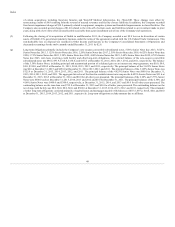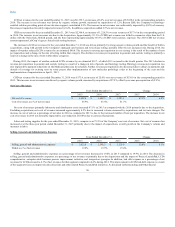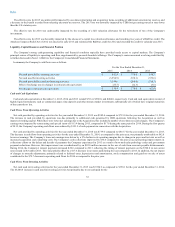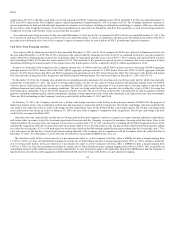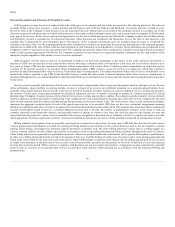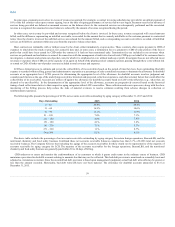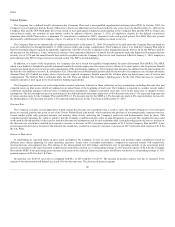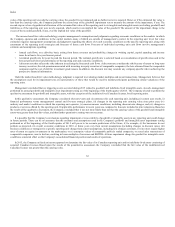LabCorp 2015 Annual Report Download - page 57
Download and view the complete annual report
Please find page 57 of the 2015 LabCorp annual report below. You can navigate through the pages in the report by either clicking on the pages listed below, or by using the keyword search tool below to find specific information within the annual report.
Index
be unable to meet its obligations as they become due within one year after issuance date. Disclosures will be required if conditions or events give rise to
substantial doubt. This standard is effective for the Company for the annual period ending after December 15, 2016, with early adoption permitted. The
adoption of this standard is not expected to have a material impact on the consolidated financial statements.
In April 2015, the FASB issued an update which requires debt issuance costs to be presented in the balance sheet as a direct deduction from the associated
debt liability. This standard became effective for the Company beginning January 1, 2016. The new guidance applies on a retrospective basis. The adoption
of this standard is not expected to have a material impact on the consolidated financial statements.
In May 2015, the FASB issued a new accounting standard allowing entities to exclude investments measured at net asset value per share under the
existing practical expedient from the fair value hierarchy. In addition, when the net asset value practical expedient is not applied to eligible investments,
certain other disclosures are no longer required. The standard became effective for the Company beginning January 1, 2016. The adoption of this standard is
not expected to have a material impact on the consolidated financial statements.
In July 2015, the FASB issued a new accounting standard that requires an entity to measure inventory, except inventory that is measured using last-in,
first-out (LIFO) or the retail inventory method, at the lower of cost and net realizable value. Net realizable value is the estimated selling price in the ordinary
course of business, less reasonably predictable costs of completion, disposal, and transportation. The standard became effective for the Company beginning
January 1, 2016. The adoption of this standard is not expected to have a material impact on the consolidated financial statements.
In September 2015, the FASB issued a new accounting standard that eliminates the requirement to restate prior period financial statements for
measurement period adjustments. The standard requires that the cumulative impact of a measurement period adjustment, including the impact on prior
periods, be recognized in the reporting period in which the adjustment is identified. The standard became effective for the Company beginning January 1,
2016 and applies prospectively to measurement period adjustments that occur after the effective date. The adoption of this standard is not expected to have a
material impact on the consolidated financial statements.
In November 2015, the FASB issued a new accounting standard that requires the deferred tax liabilities and assets to be classified as noncurrent on the
consolidated balance sheet. The standard will be effective for the Company beginning January 1, 2017, with early adoption permitted. The adoption of this
standard is not expected to have a material impact on the consolidated financial statements.
In January 2016, the FASB issued a new accounting standard that addresses certain aspects of recognition, measurement, presentation and disclosure of
financial instruments. A financial instrument is defined as cash, evidence of ownership interest in a company or other entity, or a contract that both: (i)
imposes on one entity a contractual obligation either to deliver cash or another financial instrument to a second entity or to exchange other financial
instruments on potentially unfavorable terms with the second entity and (ii) conveys to that second entity a contractual right either to receive cash or another
financial instruments from the first entity or to exchange other financial instruments on potentially favorable terms with the first entity. The standard will be
effective for the Company beginning January 1, 2018, with early adoption permitted. The Company is evaluating the impact that this new guidance will have
on the consolidated financial statements.
The preparation of financial statements in conformity with generally accepted accounting principles requires management to make estimates and
assumptions that affect the reported amounts of assets and liabilities and disclosure of contingent assets and liabilities at the date of the financial statements
and the reported amounts of revenues and expenses during the reported periods. While the Company believes these estimates are reasonable and consistent,
they are by their very nature, estimates of amounts that will depend on future events. Accordingly, actual results could differ from these estimates. The
Company’s Audit Committee periodically reviews the Company’s significant accounting policies. The Company’s critical accounting policies arise in
conjunction with the following:
• Revenue recognition and allowance for doubtful accounts;
• Pension expense;
• Accruals for self insurance reserves;
• Income taxes; and
• Goodwill and indefinite-lived assets.
57



